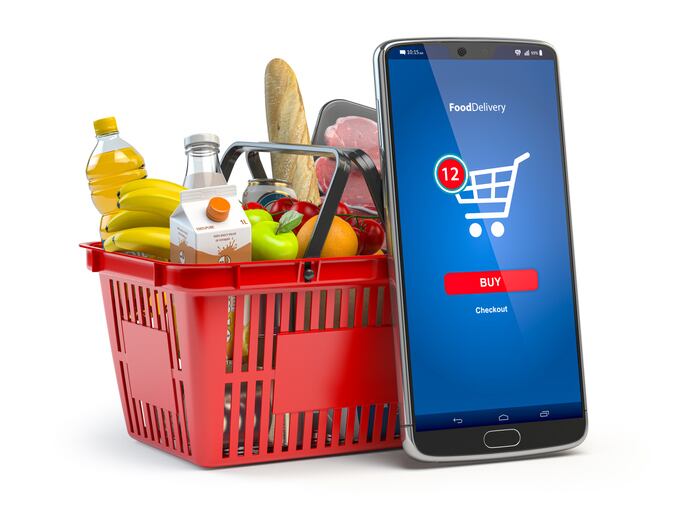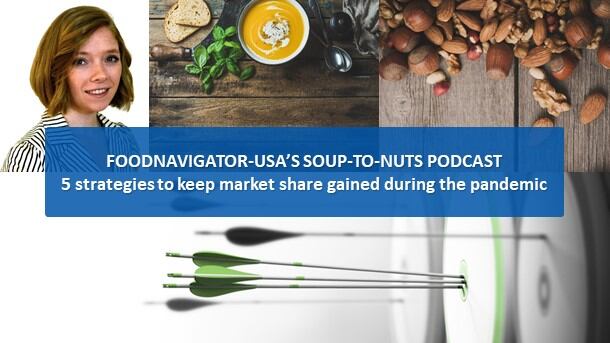The research, jointly released during FMI’s Midwinter Executive Conference, revealed Americans spent $106b on food and beverage online in 2020 – a 125% increase from the prior year. This accounted for 44% of online sales and far outpaced that of any other category – including health and beauty, which long held the lead position for online sales.
Nearly a year into the pandemic, sustained online of food and beverage sales remain elevated at about $3b more per month than in 2019 – a statistic that suggests the novelty of online grocery shopping isn’t wearing off, but rather becoming an engrained habit that will sustain even once the threat of COVID-19 ebbs, Elizabeth Buchanan, head of consumer intelligence, North America, at NielsenIQ told attendees during the executive conference.
But, she cautioned, online grocery retailers and food and beverage brands selling direct-to-consumer online should not take for granted the surge in sales and heightened consumer interest in ecommerce. Rather, she said, “merchants and brands are going to have to have a very intentional strategy for continuing to attract and gain net new shoppers, drive repeat purchase and trips online and increase average spend per shopper.”
How successful they are at this will determine the size of the prize for traditional CPG food and beverage manufacturers for online shopping in 2021, which FMI and NielsenIQ predict could range from a conservative $94b to an aggressive $109b in 2021.
Where in this scale food and beverage online sales fall this year will depend heavily on the extent to which retailers and brands understand why consumers adopted online shopping in 2020 and their collective ability to attract new shoppers, retain existing and grow overall spend, Buchanan said.
Two main drivers for online purchases in 2020
During the pandemic, two main drivers beyond safety accelerated consumer adoption of online shopping – the first was the rapid expansion of click and collect, which FMI and NielsenIQ data estimate increased 130% in orders and 113% in users in 2020.
Buchanan explained that click-and-collect and the ability to schedule pickups gave shoppers “peach of mind on things like delivery fees, scheduling and timing, and not having your groceries shop up during a conference call and sitting on your porch for an hour.”
Click-and-collect models also offered consumers control and assurance that their groceries would be transported with care and in a timely fashion. Because they would drive the products home directly form the store, rather than have their orders in the middle or near the end of a route, consumers knew their cold and frozen foods would remain temperature controlled, Buchanan added.
“The second major contributor to food and beverage growth … was Instacart,” which sold $15.7b in food and beverages online in the latest 52 weeks ending Nov. 30, 2020, Buchanan said. She added the platform had a “huge year” with a 17% increase in new merchants registering with the platform from 2019 to 2020.
Instacart gave merchants a way to quickly scale online if they didn’t have a native e-commerce business and it provided a consistent platform for new consumers to navigate.
New reasons to shop online beyond coronavirus concerns
As economies reopen and the vaccine is distributed, COVID-19 concerns will no longer be primary drivers for consumers to continue buying groceries online, but Buchanan notes enhanced safety is far from the only benefit ecommerce has to offer modern consumers.
She explains that consumers’ reasons for continuing to shop online after the pandemic will hinge significantly on how they were impacted by the outbreak and subsequent economic impact of the coronavirus.
For example, “constrained consumers” whose health, employment and financial security were negatively impacted by the pandemic (32% of the population) most likely will leverage ecommerce as a way to “shop around” for the best prices, Buchanan said.
On the other hand, “insulated consumers” who were not drastically impacted by the pandemic likely will continue to leverage online shopping because they became accustomed to purchasing a larger, broader stock of ‘essential’ products, which is easier to access online, Buchanan said. These shoppers, therefore, will be attracted to subscription services, bulk purchasing capabilities and increased convenience.
By speaking to these different need states, Buchanan said that retailers and brands can maintain much of the online gains they saw in 2020.
Still, some attrition is likely, which is why Buchanan said that online retailers and ecommerce sites will need to attract new consumers, which she said will likely required enhancing online shopping.
For example, she argues that retailers that create a more personalized online shopping experience will drive more trial and ultimately larger baskets. This goes beyond SEO and sophisticated search features to include personalized categories based on shopper needs and not traditional departments.
Buchanan noted when she signs into the Nordstrom app she is greeted by an opportunity to shop a dog walking category, which may not seem like a natural pathway, but which fits her needs and drives better suggestions for additional items.
Other strategies to engage new omnichannel shoppers going forward include collaborating with different service models and using omnishopper segmentation to prioritize branding and merchandising tactics, Buchanan said.
Finally, she notes, retailers and brands must be flexible and nimble going forward because as fast as changes occurred in 2020, consumers likely will continue to undergo significant “behavior resets for the foreseeable future,” so Buchanan said it will be up to businesses to continually assess consumer perception of value and meet them where they are.



